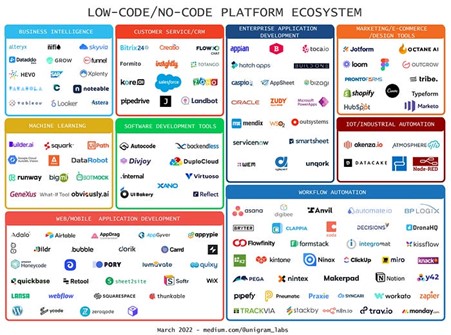Written by Peter Tubak, Head of Application Development at Messe München GmbH, and member of the UFI Digital Innovation Working Group.
Software design and development have traditionally been associated with the artistry of expert developers and programmers, but digital transformation has opened new possibilities. Low-Code and No-Code (LC/NC) platforms are tools that allow even those with less technical expertise to participate in the application development process.
In this article, our aim is to provide insights that extend beyond the tangible advantages associated with the implementation and use of these types of tools. We’ve compiled perspectives from professionals in the exhibition industry, sharing their experiences within their respective enterprises.
What are these solutions and what benefits do they bring?
Low-Code platforms are tools that enable the faster development of applications with minimal coding or programming knowledge. These tools offer a visual development environment, allowing domain knowledge experts to easily drag and drop elements, set parameters, and create complex applications without the need for in-depth coding skills.
No-Code platforms take it a step further, aiming to eliminate the need for coding. These tools typically provide pre-built templates and graphical editors, enabling users to effortlessly create websites, applications, or even automated processes without delving into the world of code.
Over the last decade, LC/NC platforms have experienced significant growth and development, driven by the increasing demand for faster and more accessible application development solutions.
“The convergence with traditional coding practices, integration of emerging technologies, and a focus on collaboration and user experience underscore key trends driving the continuous evolution of these platforms. The maturation of ecosystems, increased community engagement, and a shift towards enterprise-level scalability further highlight their significant impact on modern software development,” said Gábor Szécsi, Project Delivery Head of BCA Hungary Ltd.
These platforms can be categorized by domains based on the specific business functions they are addressing. They often provide industry-specific solutions, such as those tailored for finance, healthcare, or manufacturing, offering pre-built modules and templates to streamline development in those sectors. They may also specialize in domains like marketing, HR, and customer relationship management, allowing users to create applications tailored to their unique business requirements within these specific domains.

The benefits of LC/NC platforms include time and resource savings, as the application development process is significantly accelerated. Additionally, these tools allow less technical professionals to participate in development projects, increasing team flexibility and productivity.
Furthermore, these tools offer opportunities for simplifying and customizing business processes. Business users can easily adapt to a changing environment and create applications tailored to their needs without undergoing lengthy development processes.
“In the exhibition industry, these tools can be useful for streamlining various processes. LC platforms may facilitate the development of customized event management applications, offering features like attendee registration, schedule planning, and exhibitor management. Meanwhile, NC platforms could empower event organizers with user-friendly tools to create engaging websites, mobile apps, or promotional materials without the need for extensive coding, enhancing the overall efficiency and attendee experience in the exhibition industry.” pointed out Mirco Amberg, Director Build IT at Messe München GmbH.
Navigating the downsides: limitations and threats of LC/NC platforms
The developers also see the drawbacks of these platforms.
“While LC/NC platforms offer many advantages, it’s important to note that not every application development task is suitable for these tools. For more complex and unique requirements, traditional development methods may still be necessary. However, due to their user-friendly nature and simplicity, LC/NC platforms are increasingly becoming part of the toolkit for enterprises and individual developers. From an enterprise perspective, it’s crucial to acknowledge and consider potential drawbacks as part of the decision-making process when selecting a new solution,” said Peter Tubak, Head of Application Development at Messe München GmbH.
Let’s see the possible drawbacks in detail:7
- Missing IT Governance / standardisation: There is a potential lack of established policies and guidelines governing the development, deployment, and management of applications with LC/NC platforms. This may result in decentralized practices.
- Limited Customization: They typically rely on pre-built templates and components. While they make development quick and easy, meeting highly specific or unique requirements may be limited.
- Limited Performance: Applications built with LC/NC platforms might not achieve the performance level of applications developed with custom code, especially when handling large datasets or sophisticated algorithms.
- Dependency on Platform Providers: Users of LC/NC platforms depend on the platform provider. If the platform ceases to exist or undergoes significant changes, migration and compatibility issues may arise.
- Limited Control and Visibility over Code: In the case of No-Code tools, developers have no direct access to the code. This means developers have less insight into the details, which can complicate debugging and meeting specific requirements.
- Security Risks: Since LC/NC platforms often use pre-built components and templates, security risks may increase, especially if they are not regularly updated or inadequately managed.
“These drawbacks highlight that while LC/NC platforms can be crucial for specific projects, it’s important to carefully assess their alignment with project needs, considering limitations in sustainability and strategic fit. It is often very tempting to achieve a business result easily and quickly, but we must also take into account sustainability. Therefore, introducing these platforms into the Hungexpo environment always involves a thorough evaluation of the various aspects present in an enterprise.” said András Potmák, CFO at Hungexpo Budapest Congress and Exhibition Centre.
Recommendations for enterprise adoptions
Introducing them in a complex enterprise environment requires careful planning and a strategic approach to minimize drawbacks. Here are some recommendations:
- Strategic Planning and governance: Clearly define the specific projects and tasks where LC/NC platforms will be utilized and develop a strategic plan ensuring that the incorporation of these tools aligns with corporate goals.
- Training and Awareness: Provide comprehensive training for all employees, including both technical and non-technical staff, and build awareness at the corporate level regarding the advantages and limitations of LC/NC platforms.
- Select Appropriate Tools: Choose LC/NC platforms that adhere to corporate requirements and security standards and assess the scalability and integration capabilities of the selected platforms.
- Security and Data Privacy: Address security concerns by ensuring that LC/NC platforms comply with corporate security requirements and examine how these tools handle sensitive data and comply with legal requirements.
- Integration with Existing Systems: Confirm that LC/NC applications can seamlessly integrate and communicate with current enterprise systems and utilize APIs and other integration solutions to enhance interoperability.
- Monitoring and Maintenance: Establish a systematic process for monitoring and maintaining LC/NC applications on a regular basis and monitor performance while responding promptly to any identified issues or security risks.
- Collaboration Community: Foster communication and collaboration among developers, app builders, and business users, and create a designated community space for sharing experiences and addressing challenges collaboratively.
- Documentation: Maintain comprehensive documentation of the LC/NC development process, application functionalities, and configurations to serve as a vital reference for developers, ensuring clarity, collaboration, and effective maintenance.
According to András’s opinion, “Through proper planning, training, tool selection, and ongoing monitoring, LC/NC platforms can be effectively integrated into a complex environment, minimizing potential pitfalls and maximizing the benefits.”
How to avoid creating shadow IT in parallel with LC/NC platform introduction?
As Peter highlights: “When introducing these platforms, a potential risk is the emergence of shadow IT. Shadow IT refers to the use of information technology systems or applications that are not supported, controlled, or known by the official IT department or organization.”
This phenomenon can lead to various issues for the company, including security risks, data loss, and fragmentation of the IT infrastructure. Here are some ways to minimize the occurrence of shadow IT during the introduction of LC/NC platforms:
- Communication and Awareness: Inform employees and application builders about the company’s accepted IT policies and rules, and clearly communicate guidelines for the use of LC/NC platforms and their integration into the corporate IT strategy.
- Formal Approval Processes: Establish formal approval processes for the creation and deployment of LC/NC applications, involving the IT team in the verification and approval processes.
- Asset Monitoring and Auditing: Monitor all application development projects, including those using LC/NC platforms, and conduct regular audits to ensure control over applications and adherence to rules.
- Adherence to Security Guidelines: Ensure that LC/NC applications comply with corporate security guidelines, and regularly assess the security status of applications.
- Central IT Support: Provide central IT support and resources for LC/NC applications, offering adequate tools and assistance to developers to discourage the need for creating shadow IT.
- Joint Assessment and Feedback: Establish forums and conduct regular assessments with developers and business users for LC/NC applications, listening to feedback and addressing any potential issues.
Through strict guidelines, formal processes, and transparent communication, the emergence of shadow IT can be minimized while leveraging the benefits of LC/NC platforms for the company.
Shifted focus from technical skills to domain knowledge
If these solutions gain more and more space, how will they change the current development process?
According to Gábor, the focus will be elsewhere in the future. “Domain knowledge will play a pivotal role in the future, as professionals will need a deep understanding of industry-specific nuances and challenges. Integrating technical skills with domain expertise enhances problem-solving abilities and ensures that technological solutions align closely with business objectives.”
Professionals with a deep understanding of domain-specific nuances will become indispensable. This shift not only redefines the skill set required but also underscores the importance of aligning technological solutions closely with business objectives for sustained innovation and success.
Key takeaways
In conclusion, leveraging LC/NC platforms in software development demands careful consideration of their advantages and limitations. Industry insights highlight the transformative potential of these tools, providing practical glimpses into their applications and the evolving software development landscape. Organizations can maximize the benefits of LC/NC platforms through strategic planning, considering potential drawbacks, and ensuring sustainability. The ongoing shift from technical skills to domain knowledge signals a paradigm change, emphasizing the importance of a holistic approach that integrates diverse skill sets for continued innovation and business success.







Leave A Comment